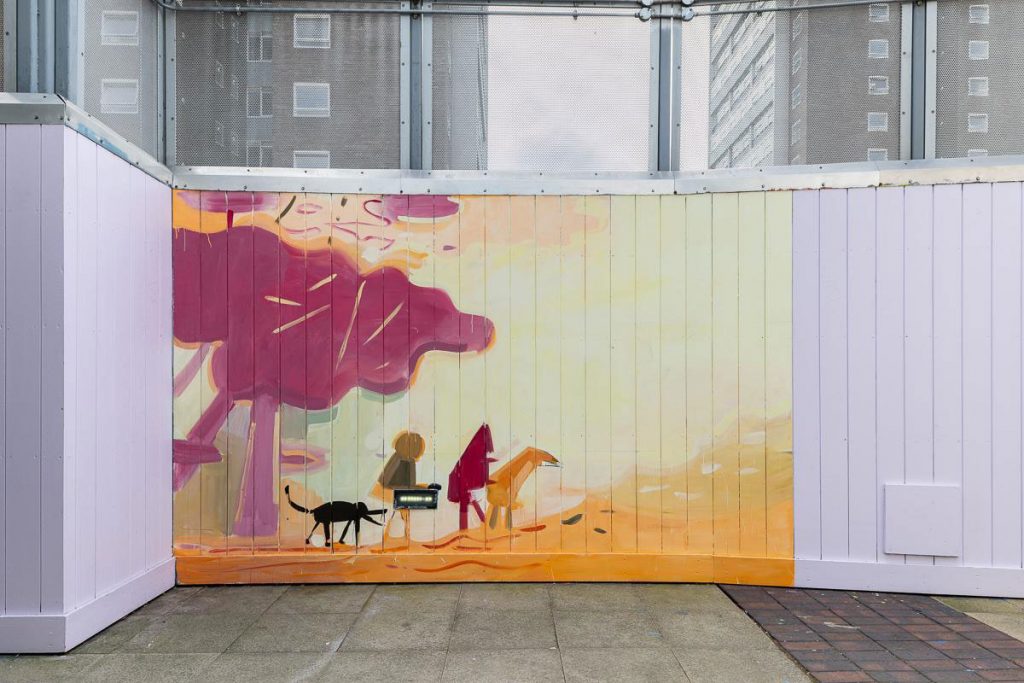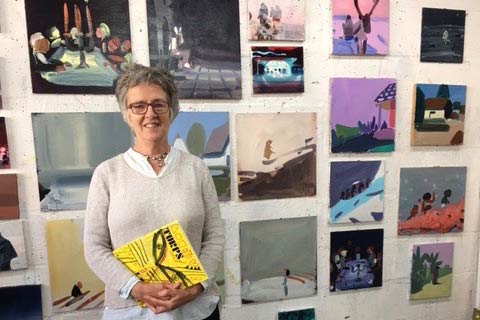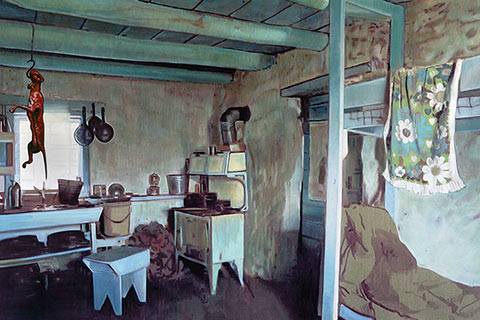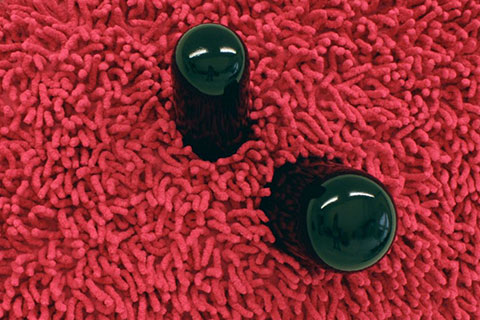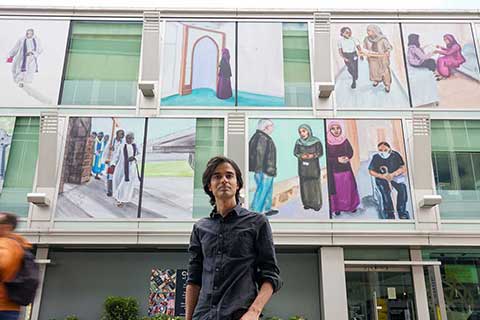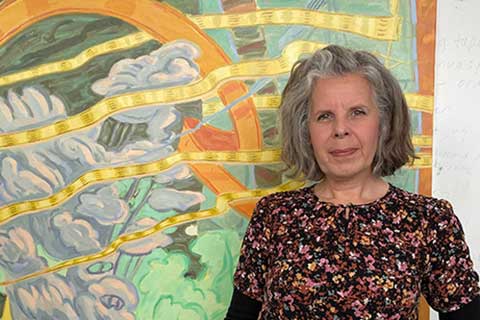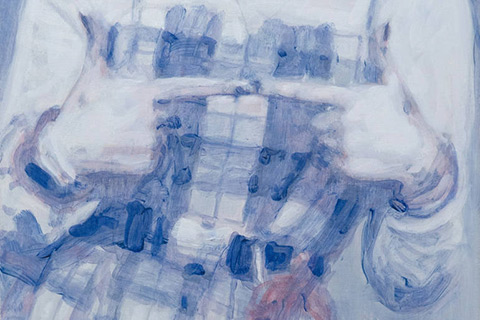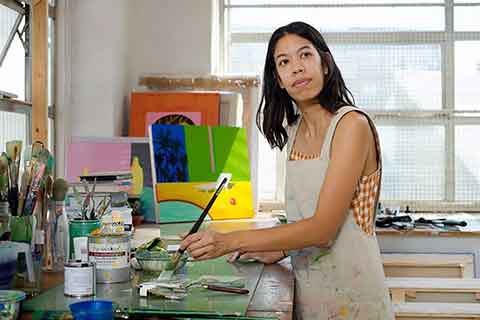Susie Hamilton: Artist of the Month
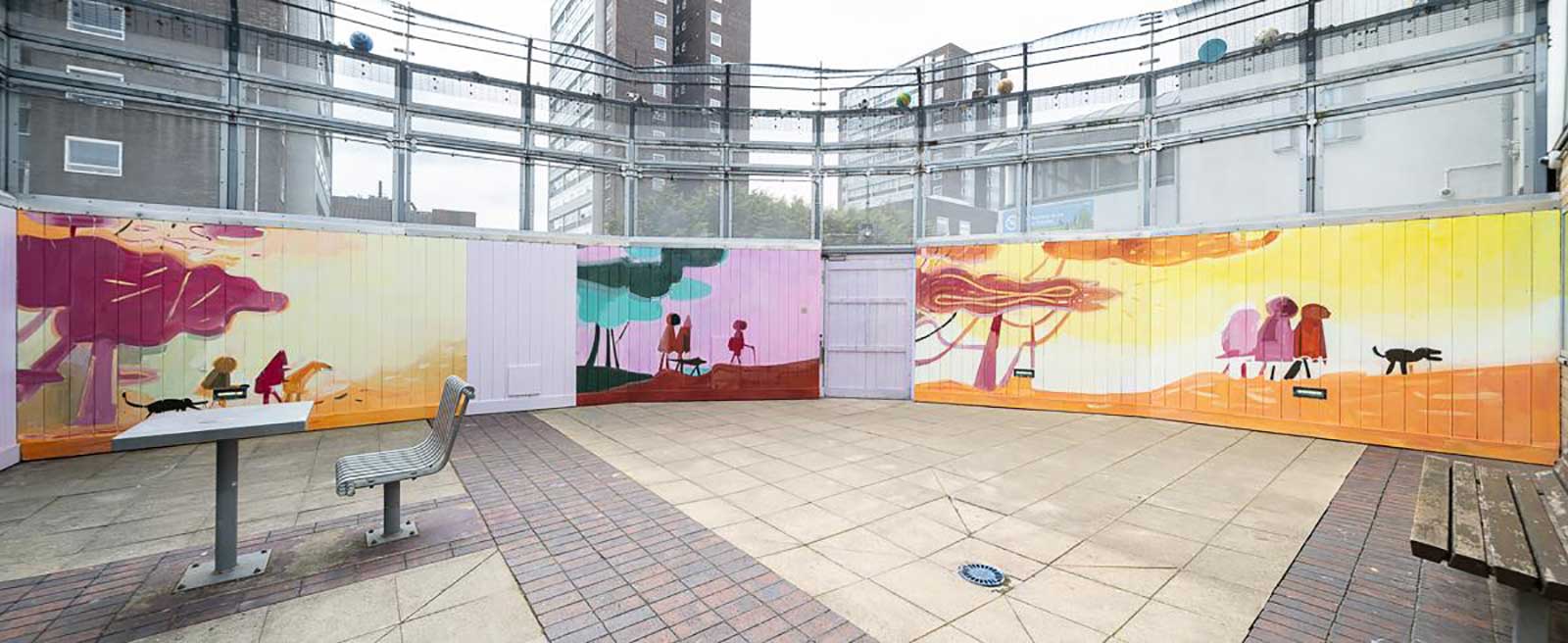
Artist of the Month June 2021: Susie Hamilton, selected and interviewed by Paul Newman for CBP.
Susie Hamilton discusses her C-19 series produced in her home studio during the lockdowns of 2020-21 depicting masked and visored medics treating patients during coronavirus pandemic. Susie also talks about her Hospital Rooms commission for the courtyard of Askew Ward, Hammersmith, 2021.
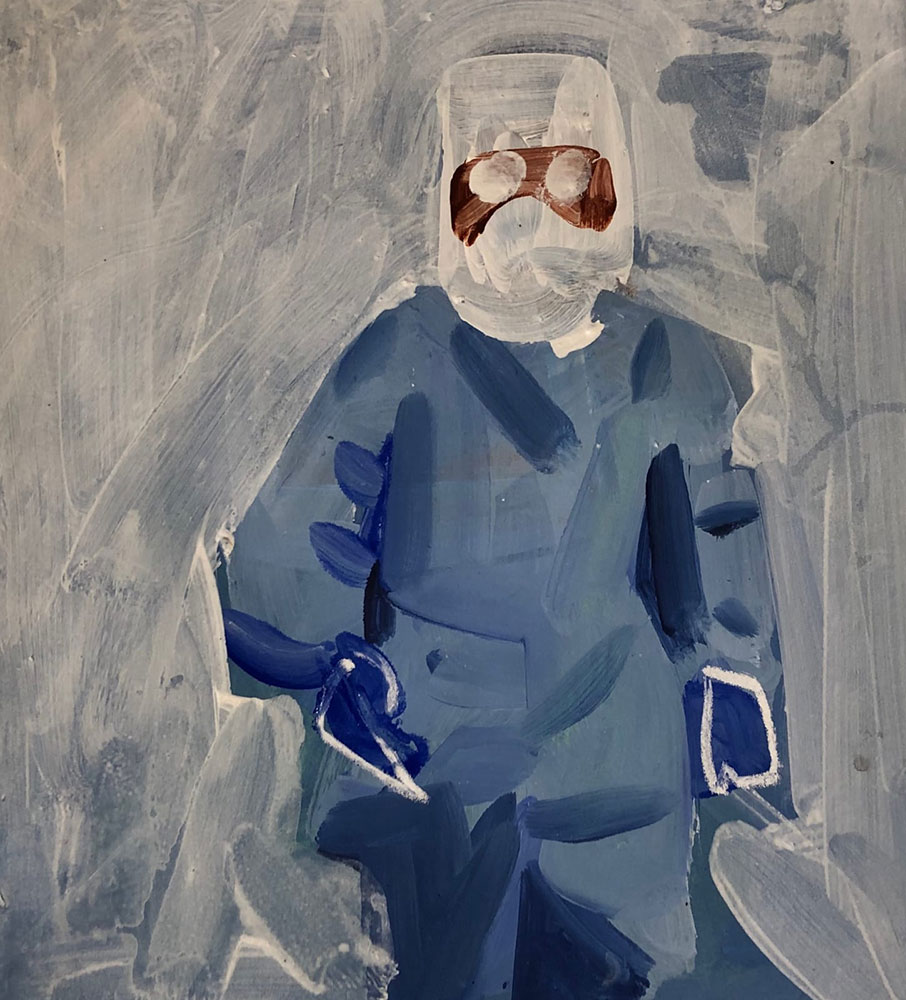
CBP: Can you introduce the C-19 series of Hospital Doctors in PPE treating patients. Did you use photographic imagery or tv news stills and if so how did you obtain and select the imagery to work with?
Susie Hamilton: The series began when I was contacted by consultant hepatologist and art collector, Peter Collins who had bought my paintings before and thought that images of Covid wards might interest me. He sent me photos from his Bristol hospital and I then sourced more from documentaries and TV news, just snapping images on my phone.
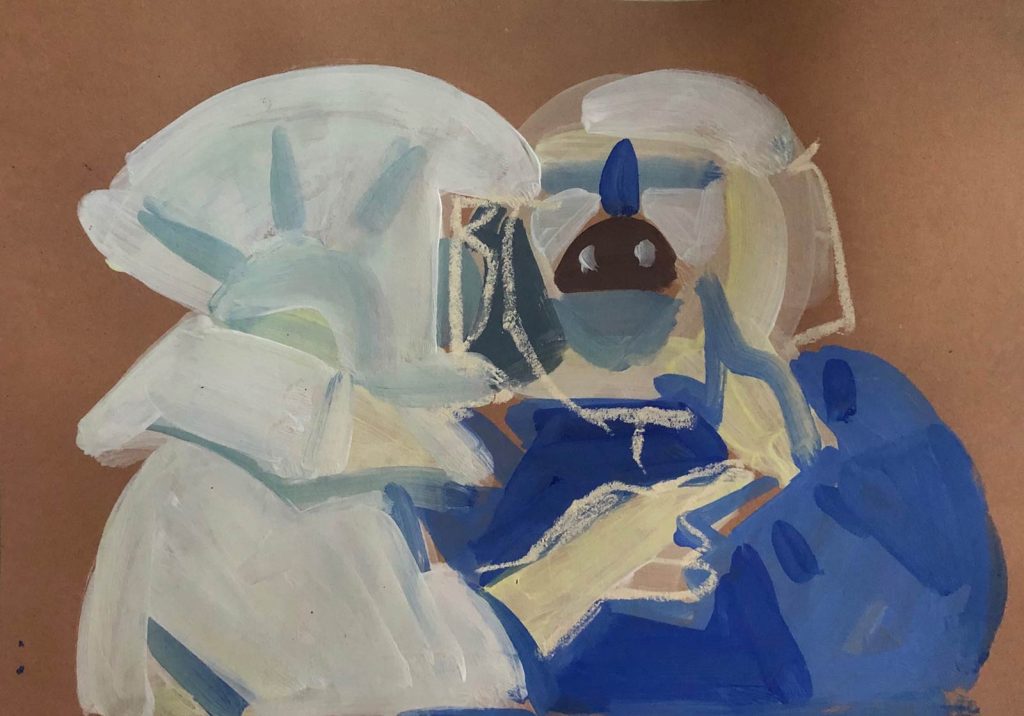
CBP: With such emotive subject matter depicting life saving and life ending scenarios, many artists working with the pandemic theme considers their choice of imagery and how to depict it without being sentimental. And yours certainly aren’t. They are very direct and powerful paintings, though with a critical distance in terms of deftly balancing the human drama and tragedy with the language of painting itself, which adheres to your fluid signature style of partly formed or dissolving figures. Can you discuss the relationship with the subject and your own approach to painting?
SH: Maybe my desire to evoke fear and strangeness stops the pictures being twee or sentimental. The Covid doctors are alarming versions of my earlier figures (astronauts, riders, hooded polar explorers) that are masked and disguised. And then they are transformed further by the ‘fluid’ style that you mention, as are the Covid patients who are turning into mess and water. It is as if both doctor and patient are threatened in the process of painting, the paint and painter allowing the firmness of outline or identity to slip away towards something uncertain and metamorphic.
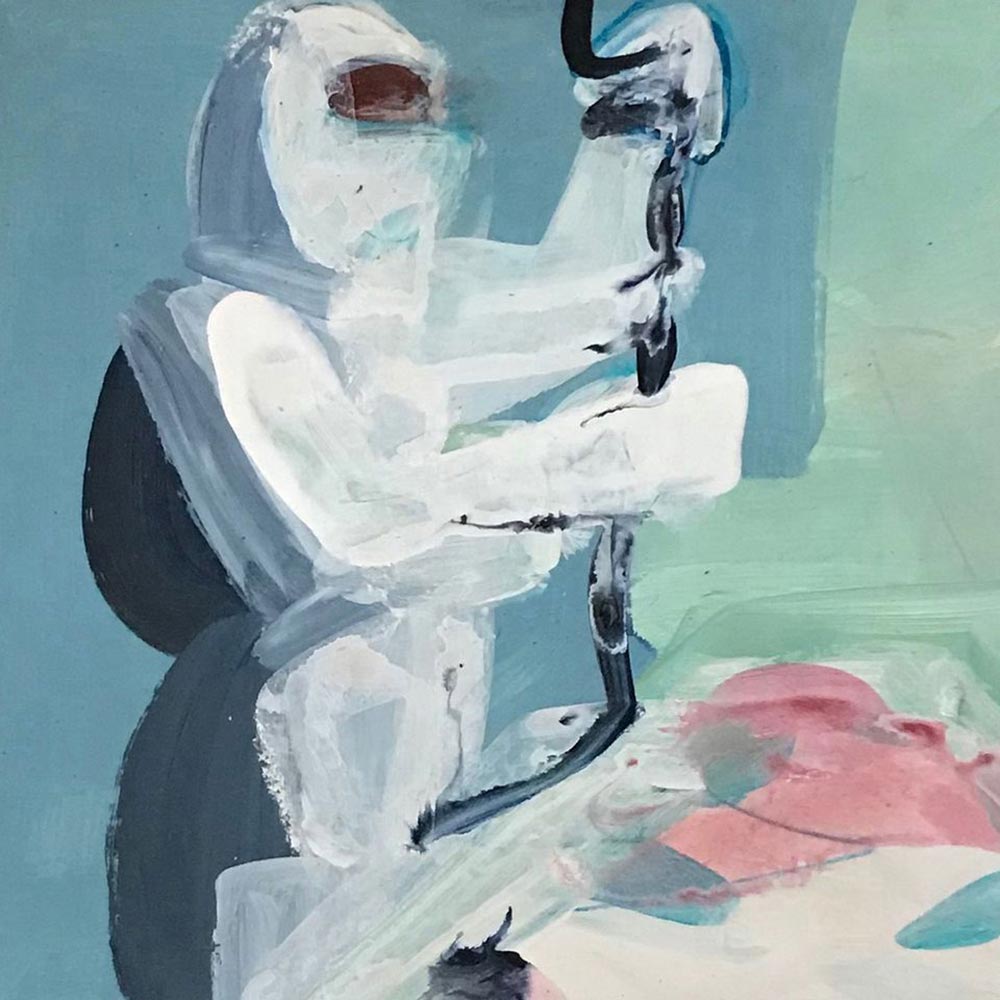
CBP: There are tonal layers in the series from a sense of anxiety, the heroic, to the playful and humorous and almost absurdity. And there is an essence of something sinister too. Some of your hooded dark goggled doctors in PPE remind me of images of the beaked plague doctors from the 16th Century. Was this a reference point in making these works? If not then they are certainly alien and futuristic. Could you discuss the points of inference with these figures?
SH: I’m keen on ambivalent images that, for example, embrace humour and pain, with suffering made worse if grotesque or ridiculous. And yes, I intended the reference to 16th c plague doctors. There’s a photo of one of these beaked and gowned figures on a notice board in Mile End Park which I see on my way to the studio. It has always scared me and the kit of Covid medics reminded me of it. The futuristic element is there as well, with doctors like sci-fi figures. I like to paint people on a threshold between the familiar and the unfamiliar, as in my ‘Beach’ paintings with sunbathers beneath black skies. So my Covid patients are on a borderline between the everyday world and one of Covid-induced hallucinations, or between life and death. These fearful, masked figures of doctors loom up as if from another world. Then the expanded microscopic life that I painted in the Beach series, returns here with viral motifs floating around bedsides to increase a sense of oddness.
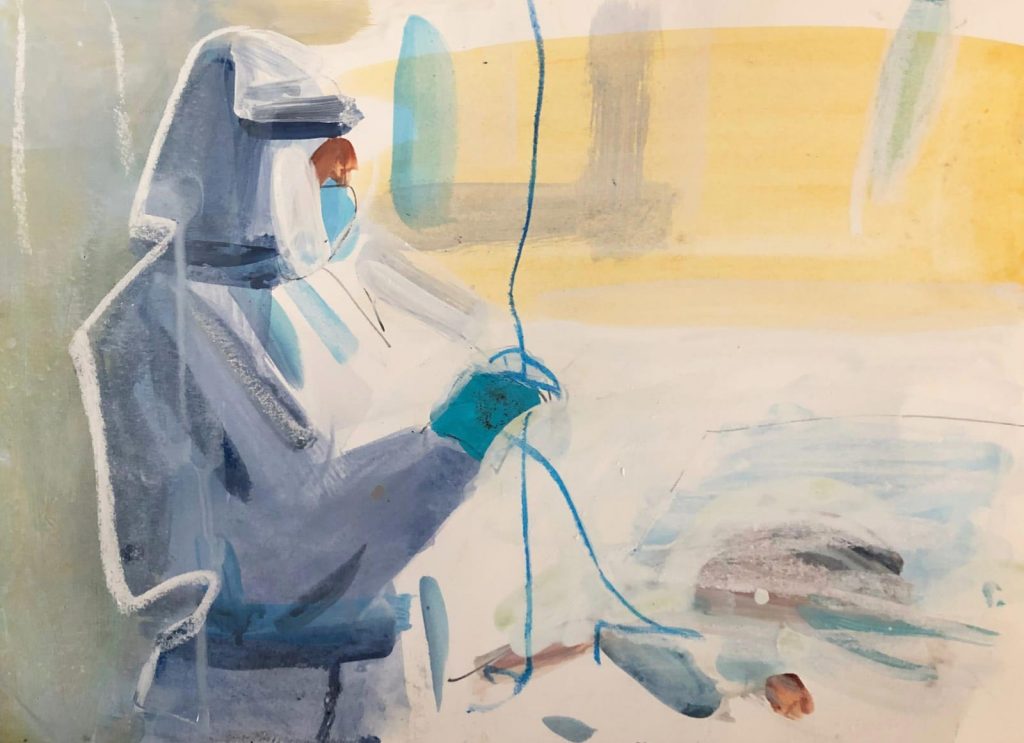
CBP: Your approach to painting appears incredibly spontaneous and economical with the information sketched in or distilled to the essence of depicting the necessary information, perhaps for the audience to complete the work in their own imagination with some kind of shared psychology. Could you discuss something of the psychology and interior world of your painting in general?
SH: I like the idea of making a distilled, economical image that is the result of many preliminary drawings from life. And I’m also interested in turning a figurative image towards something abstract and mysterious. The border between the known and unknown again! And yes, you’re right, I want this image to be discovered or explored by the viewer, not to be too pat or obvious. I like the sensation of doubt and struggle in encountering an image as if the painting presents us with an enigmatic shape that has to be deciphered. It is as if you encounter the abstract impact of a painting before you know what it represents. Or it’s as if you’re pushing the recognisable towards uncertainty and exchanging the known for the unknown. For me representational images morphing into abstraction contrast two ways of seeing: seeing things as named objects or as nameless shapes. Such transformations therefore threaten the everyday world of labels and nouns with the unnamed and unnameable.
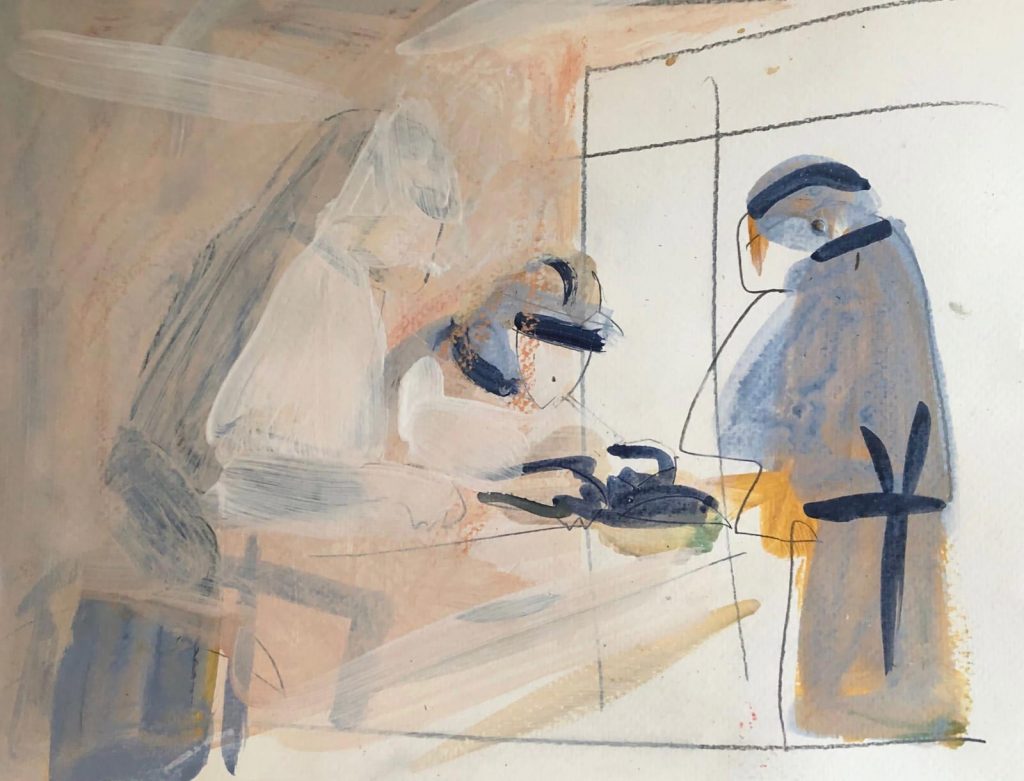
CBP: Do you complete these works in one take or rework them? Do you work on several at once?
SH: Yes I work on several at once and while some are done very quickly and I decide to leave them alone, others need hours of reworking and revisiting until they seem to have the right degree of visual drama or of balance between figurative and abstract elements.
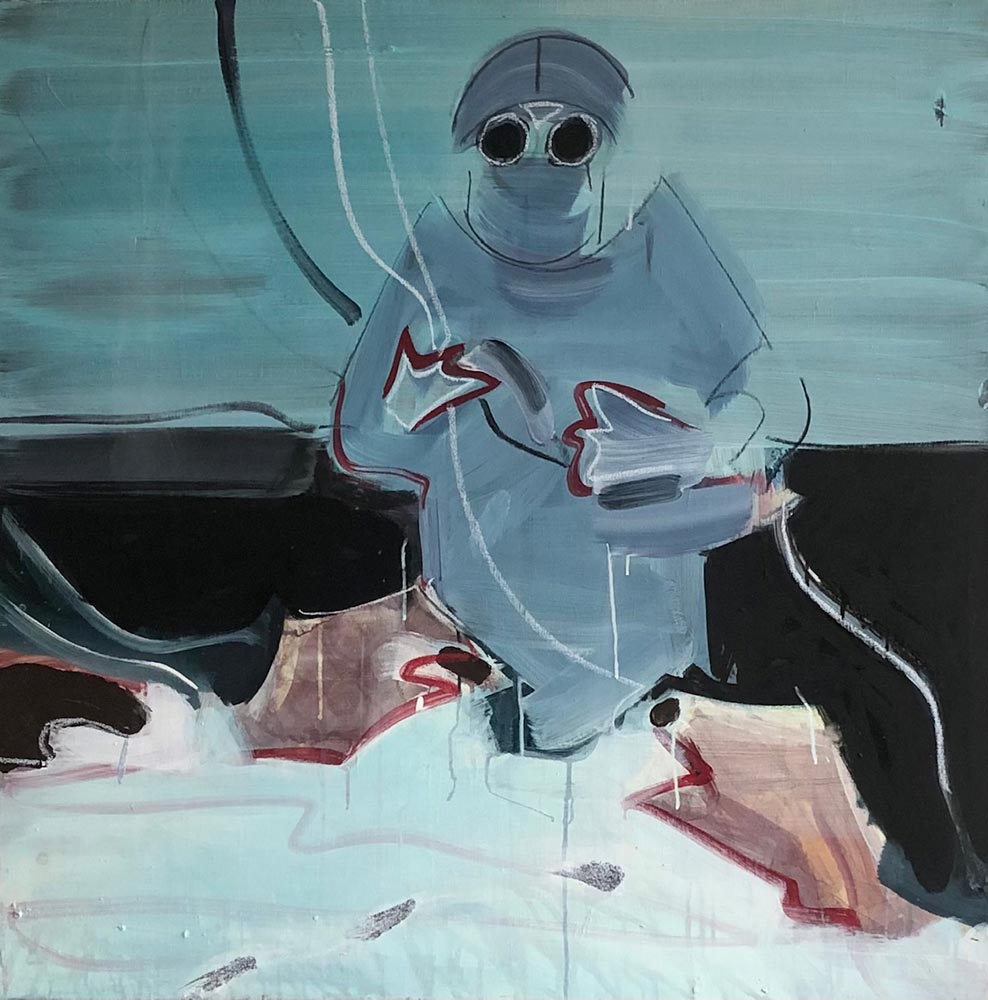
CBP: Moving on to the Askew hospital mural commission, It appears an incredibly spontaneous and atmospheric work and with an intriguing narrative of these figures or family with a dog on a walk in the countryside, or being led on a dream journey. Its colorful and playful, childlike and sophisticated. How did you decide on the imagery for it and the balance of its appeal for visitors of all ages?
SH: It grew out of a mural I’d done before for Hospital Rooms, in a PICU in Exeter. This was of a Sami reindeer herder on a journey with her animals towards light. For the courtyard of Askew Ward I wanted to introduce images of radiant nature in a grim, grey setting and I wanted to develop the idea of the journey with three pictures of figures and an animal at different stages. They are evolving, going forward and, for me, express hope and persistence in the wilderness of a world which is both beautiful and dangerous. Light is an important element in the paintings and they are moving towards increasing brightness.
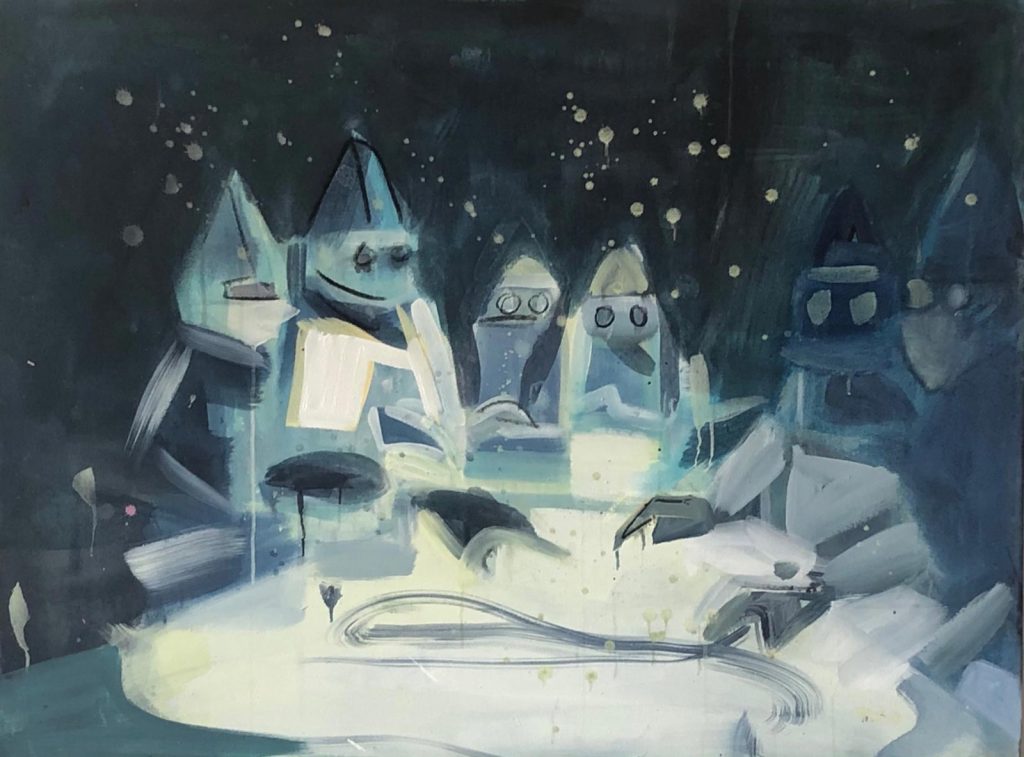
CBP: Did you scale up smaller studies for it, with scaled up painting tools or was any of it improvised? How did the challenge differ from your normal painting routine?
SH: I did preliminary paintings/drawings and scaled them up, measuring everything very precisely because the work needed to be done reasonably swiftly. The WHO programme called ‘Healing Arts: The Future is Unwritten’ did a filmed interview with Ben Luke and I wanted to have something to show for the film. Of course nothing can be totally foreseen and there were hours of improvisation and difficulty when the murals didn’t do exactly what I’d planned. They were much bigger than my paintings on canvas and more challenging because of this. But I had some terrific helpers, Louis, Phoebe and Charlotte from Hospital Rooms, and this made it all quicker and easier.
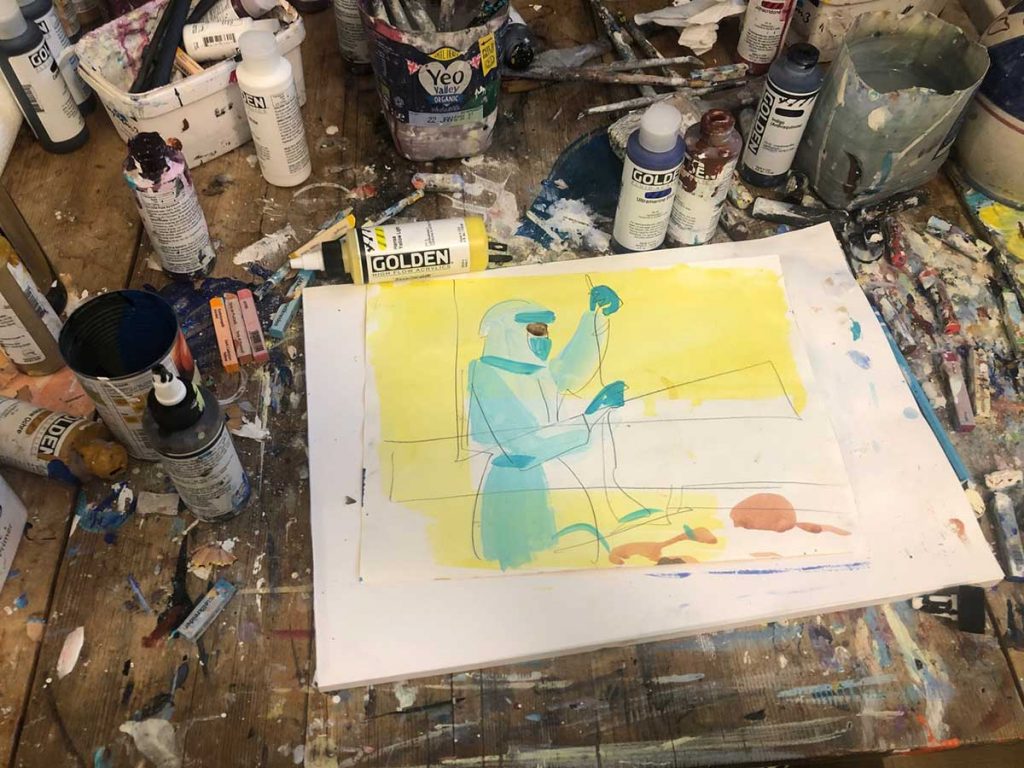
CBP: You work primarily in acrylics, is this choice of medium important to the approach and sensibility of your painting?
SH: Yes, because I can more easily make my dissolving, mutating figures with such a fluid medium. I like to pour it on surfaces, blow it with a hairdryer or drop washing up liquid into it so that it blooms out into ‘cells’. I also like to paint in veils and layers and acrylic allows me to do this more easily because it dries fast.
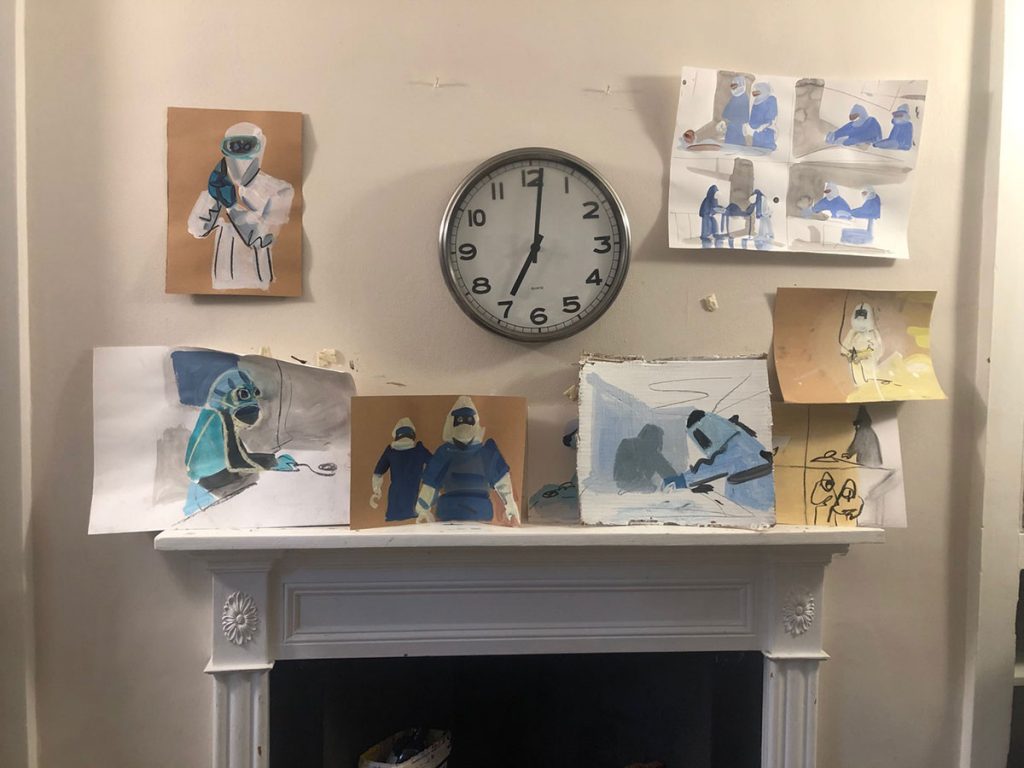
CBP: Was the Covid PPE series painted at home in lockdown and what is your current studio routine?
SH: Yes it was. Our kitchen was partly transformed into a studio and Peter, my husband, didn’t mind me covering an ever-increasing area with paintings, drawings, pastels, charcoal and paint. I also used materials like cardboard that I got from delivery boxes during lockdown. I’m now back at the studio on most days as I’m working on a larger scale, but I’m still doing smaller things at home, for instance a series of ‘Bears’ for Art Car Boot fair ‘Fauna and Flora’ event.
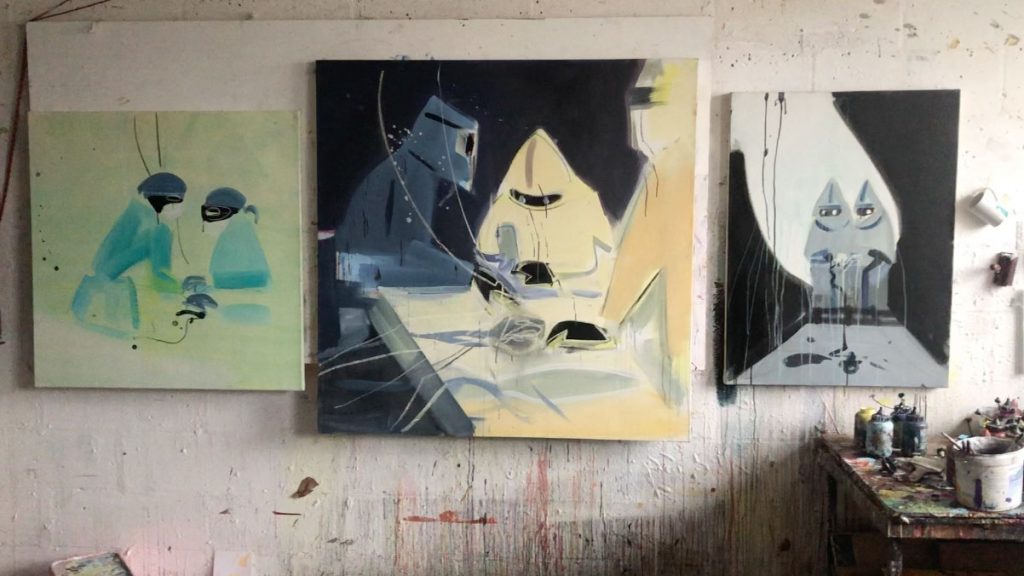
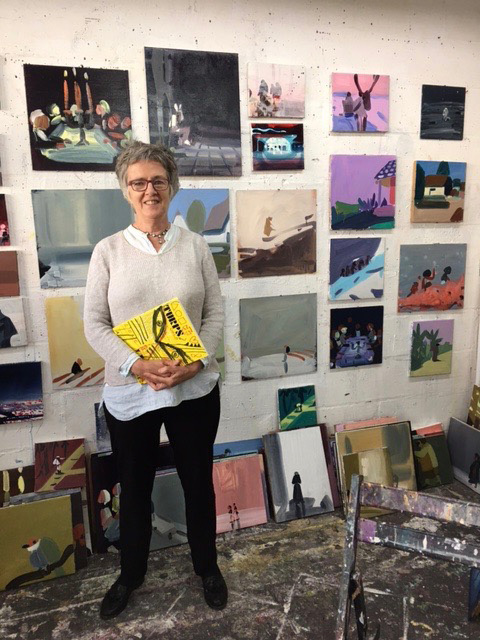
Susie Hamilton is represented by Paul Stolper, London. Solo exhibitions include Ecstasy’, 2021 & C-19, 2020 online Viewing Room, Paul Stolper, London; ‘On Margate Sands’, Paul Stolper (2018); Here Comes Everybody, St Paul’s Cathedral, London (2015); Black Sun, Studio Opdal, Flo, Norway (2009); World of Light, Triumph Gallery, Moscow (2008); New Paintings, Galleri Trafo, Oslo (2007). Group shows include Picture Palace, Transition Gallery (2020), Beyond Other Horizons, Palace of Culture, Iasi (2020); Hospital Rooms, Phoenix Gallery, Exeter (2019); Frieze, London (2018); The Art of the Circus, RWA, Bristol (2018); Small is Beautiful, Flowers Gallery, London (2019, 2018); John Moores Painting Prize, Walker Art Gallery, Liverpool (2014, 2004); Jerwood Drawing Prize (2012)
Further links:
Artist’s House Calls – Susie Hamilton
http://www.susiehamilton.co.uk/
